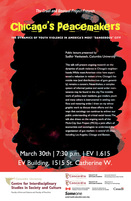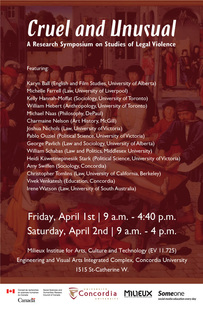Statement
What separates legal violence from illegitimate violence? There is a traditional distinction between punishment and vengeance: punishment being the sanctioned use of measured violence and vengeance being the unsanctioned use of violence without measure. This division is expressed by the prohibition on “cruel and unusual punishment,” originally found in the English Bill of Rights (1689), and now in a number of constitutions and declarations around the world, including the Universal Declaration of Human Rights, the United States Constitution, and the Canadian Charter of Rights and Freedoms. Despite the various permutations, what is at stake in the phrase is clear: legal violence is subject to limitation. The difficulty lies in the determination of the limit. A number of phrases have developed in different legal orders that attempt to add some degree of precision. It is said, for example, that punishment must respect “human dignity,” it must not “shock the conscience of society,” it must respect what is “reasonable in a free and democratic society,” but these standards remain normative guidelines. Their application is historically situated and constituted by a host of extra-legal factors in the form of social, economic, and political forces. Adding to the complexity is the changing nature of the law’s use of violence in the contemporary moment. The distinction between torture and “enhanced interrogation,” the use of “extraordinary rendition” and “black sites,” and humanitarian interventions that breach the sovereignty of nation-states, give a sense of the scope and stakes of legal violence today. The Cruel and Unusual project set out to address these issues by opening up the question of the relationship between law and violence to experts working in a plurality of disciplines doing cutting edge work on legal violence
What separates legal violence from illegitimate violence? There is a traditional distinction between punishment and vengeance: punishment being the sanctioned use of measured violence and vengeance being the unsanctioned use of violence without measure. This division is expressed by the prohibition on “cruel and unusual punishment,” originally found in the English Bill of Rights (1689), and now in a number of constitutions and declarations around the world, including the Universal Declaration of Human Rights, the United States Constitution, and the Canadian Charter of Rights and Freedoms. Despite the various permutations, what is at stake in the phrase is clear: legal violence is subject to limitation. The difficulty lies in the determination of the limit. A number of phrases have developed in different legal orders that attempt to add some degree of precision. It is said, for example, that punishment must respect “human dignity,” it must not “shock the conscience of society,” it must respect what is “reasonable in a free and democratic society,” but these standards remain normative guidelines. Their application is historically situated and constituted by a host of extra-legal factors in the form of social, economic, and political forces. Adding to the complexity is the changing nature of the law’s use of violence in the contemporary moment. The distinction between torture and “enhanced interrogation,” the use of “extraordinary rendition” and “black sites,” and humanitarian interventions that breach the sovereignty of nation-states, give a sense of the scope and stakes of legal violence today. The Cruel and Unusual project set out to address these issues by opening up the question of the relationship between law and violence to experts working in a plurality of disciplines doing cutting edge work on legal violence
Participants
Karyn Ball (English and Film Studies, University of Alberta)
Michelle Farrell (Law, University of Liverpool)
Kelly Hannah-Moffat (Sociology, University of Toronto)
William Herbert (Anthropology, University of Toronto)
Michael Naas (Philosophy, DePaul)
Charmaine Nelson (Art History, McGill)
Pablo Ouziel (Political Science, University of Victoria)
George Pavlich (Law and Sociology, University of Alberta)
William Schabas (Law and Politics, Middlesex University)
Heidi Kiiwetinepinesiik Stark (Political Sience, University of Victoria)
Christopher Tomlins (Law, University of California, Berkeley)
Vivek Venkatesh (Education, Concordia)
Irene Watson (Law, University of South Australia)
Organisers
Amy Swiffen (Sociology & Anthropology, Concordia University, Canada)
Joshua Nichols (Law, University of Victoria, Canada)
Karyn Ball (English and Film Studies, University of Alberta)
Michelle Farrell (Law, University of Liverpool)
Kelly Hannah-Moffat (Sociology, University of Toronto)
William Herbert (Anthropology, University of Toronto)
Michael Naas (Philosophy, DePaul)
Charmaine Nelson (Art History, McGill)
Pablo Ouziel (Political Science, University of Victoria)
George Pavlich (Law and Sociology, University of Alberta)
William Schabas (Law and Politics, Middlesex University)
Heidi Kiiwetinepinesiik Stark (Political Sience, University of Victoria)
Christopher Tomlins (Law, University of California, Berkeley)
Vivek Venkatesh (Education, Concordia)
Irene Watson (Law, University of South Australia)
Organisers
Amy Swiffen (Sociology & Anthropology, Concordia University, Canada)
Joshua Nichols (Law, University of Victoria, Canada)

Keynote Lecture
A public lecture by Sudhir Venkatesh titled Chicago’s Peacemakers: The Dynamics of Youth Violence in America’s Most “Dangerous” City. The lecture was recorded by the Someone Project and can be viewed here. Dr. Venkatesh is William B. Ransford Professor of Sociology at Columbia University renowned for his urban ethnographies, including Gang Leader for a Day: A Rogue Sociologist takes to the Streets. His lecture was sponsored by the Centre for the Interdisciplinary Study of Society and Culture.
A public lecture by Sudhir Venkatesh titled Chicago’s Peacemakers: The Dynamics of Youth Violence in America’s Most “Dangerous” City. The lecture was recorded by the Someone Project and can be viewed here. Dr. Venkatesh is William B. Ransford Professor of Sociology at Columbia University renowned for his urban ethnographies, including Gang Leader for a Day: A Rogue Sociologist takes to the Streets. His lecture was sponsored by the Centre for the Interdisciplinary Study of Society and Culture.

Cruel and Unusual Workshop
Friday, April 1st | 9 am - 4:40 pm
Saturday, April 2nd | 9 am - 4 pm
Milieux Institute for Arts, Culture and Technology (EV 11.725)Sunday the Engineering and Visual Arts Integrated Complex
Concordia University,
1515 St-Catherine W.
Friday, April 1st | 9 am - 4:40 pm
Saturday, April 2nd | 9 am - 4 pm
Milieux Institute for Arts, Culture and Technology (EV 11.725)Sunday the Engineering and Visual Arts Integrated Complex
Concordia University,
1515 St-Catherine W.
This research was supported by the Social Sciences and Humanities Research Council of Canada.
